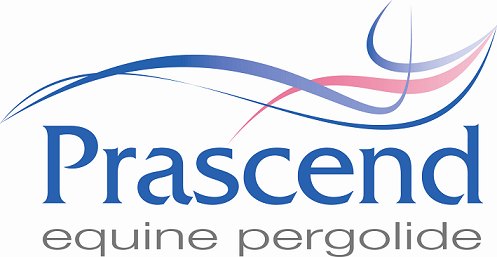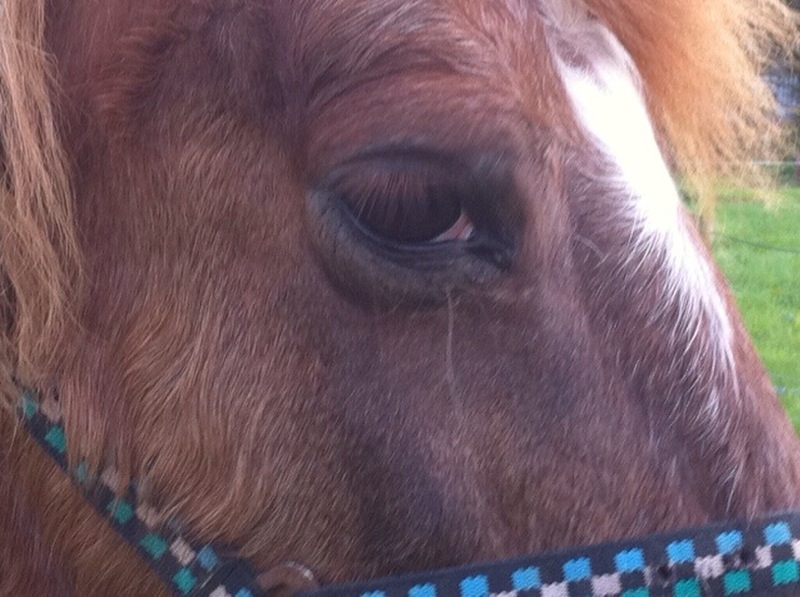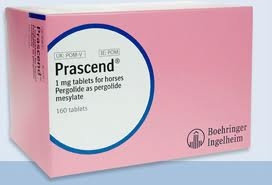Pituitary Pars Intermedia Dysfunction (PPID) in the Horse
Katie Snalune BSc MA VetMB Cert EM (Int.Med.) Cert ES (Soft Tissue) MRCVS - 21/04/2013
Pituitary Pars Intermedia Dysfunction (PPID) in the Horse
The only common endocrinopathies encountered in equine practice are pituitary pars intermedia dysfunction (PPID, Equine Cushing’s Disease) and Equine Metabolic Syndrome (EMS). Thyroid, adrenal and parathyroid disorders are extremely rare.
Pathophysiology of PPID
Hyperadrenocorticism in horses is almost invariably a result of pituitary disease (only one reported case of adrenal hyperadrenocorticism in horse with functional adrenocortical adenoma: van der Kolk et al., 2001). There is debate regarding the precise pathologic classification (adenoma vs. hyperplasia), but as it is specifically the pars intermedia (PI) that is affected, the condition is more accurately referred to as pituitary pars intermedia dysfunction. The secretory capacity of the PI in a normal horse is autonomously active and controlled by chronic inhibition by dopaminergic neurons from the hypothalamus. The primary pathophysiologic event in PPID is oxidative damage to these tonic inhibitory dopaminergic neurons leading to hypersecretion of the uninhibited PI and adenomatous hyperplasia within the PI. The main secretory products of PI include α-melanocyte-stimulating hormone (α-MSH), β-endorphin (β-END), corticotrophin –like peptide (CLIP) and some adrenocorticotrophic hormone (ACTH). The main source of ACTH in the pituitary gland is the pars distalis (PD) which is unaffected in PPID. Nevertheless, the adrenal cortex becomes hyperstimulated by the relatively small increase in ACTH along with the synergistic adrenocorticotrophic effect of α-MSH and β-END. The resulting increased cortisol secretion has no negative feedback effect on the PI as it only has this effect on the PD. CLIP may have the additional effect of stimulation of pancreatic β cells to secrete insulin. Insulin secretion may also be increased in response to insulin resistance induced by cortisol hypersecretion.
Signalment of PPID Cases
- Probably a normal ageing feature with loss of dopaminergic inhibitory neurons as a result of oxidative damage
- <15yo unlikely
- 15-20yo possible
- >20yo probable
- Some studies of horse populations suggest that 15-40% of horses and ponies >15 years old are affected by the condition to some degree
- No gender or breed association
Common Clinical Signs
- Hirsuitism… very common, often starting in early years by slow shedding of winter coat, and/or longer hairs on mandible and palmar/plantar aspect of limbs, followed by retaining coat, and eventually thick hair growth within a month or two of clipping at any time of year. Pathognomonic (83% sensitivity)
- Laminitis… frequent feature of PPID, presumably due to increased corticosteroid effect and insulin resistance. Also common to see changes suggestive of laminitis when examining feet despite absence of clinical signs of laminitis
- Polydipsia/polyuria… reasonably common but not always recognised by owner. May result from direct corticosteroid effect on renal tubules or as result of cortisol-induced Diabetes mellitus, or more rarely Diabetes insipidus
- Lethargy… commonly present, owners presume lethargy simply associated with old age. Frequent improvement in this sign in response to treatment suggests genuine presence. Possibly consequence of increased β-END secretion
- Excessive sweating… fairly frequent feature. Cause not clear, but may be related to dysregulation of thermoregulation in hypothalamus or potentiating effects of corticosteroids on adrenoceptors in sweat glands
- Fat redistribution… general pot bellied appearance and bulging supraorbital fat pads. Some describe “bags under the eyes” as more common and pathognomonic for PPID
Less Common Clinical Signs
- Susceptibility to infection… due to the immunosuppressive effects of increased cortisol secretion. Listed infections reported include skin (11%), lung (11%), sinus (7%), oral (7%) and other (8%)
- Weight loss… catabolic effects of hypercortisolaemia and insulin resistance may lead to weight loss, but rarely marked. If marked, further cause should be investigated. Not uncommon for other conditions to coexist
- Neurological signs… rarely reported in PPID, presenting with blindness, collapse or seizures, presumably associated with increased pressure on base of brain associated with expanding pituitary gland
- Pruritis… a not infrequent presentation, usually in winter months. Louse infestation common with long hair coat. However, not always found – syndrome not reported in literature
- Reproductive changes… acyclicity, irregular cyclicity, lactation without pregnancy
Diagnostics
PPID is problematic to diagnose in horses and there are a multitude of basal and dynamic diagnostic tests proposed. Only a few diagnostic tests have been subjected to well controlled scientific studies in which results of tests have been compared between horses with and without PPID with the diagnosis confirmed by the gold standard PM evaluation. There are four tests with support from post-mortem evidence based studies:
- Overnight Dexamethasone suppression test
- Resting serum ACTH concentration
- TRH stimulation test
- Combined Dexamethasone suppression – TRH stimulation test
Overnight Dexamethasone suppression test
Protocol
- Take a serum sample for baseline cortisol at approximately 5pm
- Adminster 10μg/kg Dexamethasone (abbreviated to “dex” for rest of article) IM/IV (10ml of 2mg/ml solution/500kg)
- Collect 2nd serum sample approximately 19 hours later (11am next day) for analysis of post-dex cortisol concentration
Interpretation... NORMAL - 19 hour cortisol concentration < 27nmol/l PPID - 19 hour cortisol concentration > 27nmol/l
Dybdal et al. 1994 – 43 PPID 18 control. None of PPID < 27nmol/l, all 18 normal < 27nmol/l
Can get false negatives/positives, and a seasonal variation in that up to 50% horses might fail to suppress in response to dex in summer/autumn. Overall it is a good test with reasonably high diagnostic accuracy. The risk of laminitis probably overstated as:
- Dose used is small and only given once
- No difference on prevalence of laminitis following dex suppression comparing dex vs. non-dex groups
- Reeves et al. 2001 – doesn’t exacerbate disease in laminitic ponies
Resting plasma ACTH concentration
Van der Kolk et al. 1995 compared resting plasma ACTH concentrations in 16 horses confirmed to have PPID at post mortem with 7 control horses. Control horses had plasma ACTH of 2-11pmol/l. PPID horses had a range of 23 – 220pmol/l, suggesting 100% sensitivity and specificity. However, there is a marked effect of seasonality on ACTH concentration, such that a high proportion of normal horses have significant increases in plasma ACTH in the Autumn. Samples must be collected in a plastic EDTA tube, spun down in a centrifuge and sent chilled to the laboratory.
TRH stimulation test
Protocol
- Take a baseline blood sample for cortisol ( or ACTH?)
- Inject 1mg TRH IV
- Take a further blood sample 30 minutes later for assessment of post-stimulation cortisol (or ACTH?)
Mac Farlane et al. (2005) looked at 16 normal horses and 7 PPID horses (5 confirmed at PM) and showed that both normal and PPID horses will often show a significant increase in cortisol after TRH injection. Although PPID horses typically had a higher percentage increase, there was no significant difference between controls and PPID horses.
Mac Farlane et al. (2005) also looked at ACTH levels in response to TRH stimulation and this did show a significant difference between PPID and normal horses with higher resting ACTH in PPID than normal horses. This is not a routinely used diagnostic protocol but is worth investigating further. However, TRH is currently unavailable and very expensive.
The combined TRH stimulation and Dexamethasone suppression test
This combination test was developed on the basis that two dynamic response might increase the probability of making a positive diagnosis in suspected PPID cases. However, it may magnify inaccuracies in both tests.
Protocol
- Measure basal serum cortisol (1) at 9am
- Inject 40μg/kg dexamethasone IM/IV
- Measure serum cortisol (2) at 12 noon
- Inject 1mg TRH IV
- Measure serum cortisol (3)20 mins after TRH (12.30pm)
- Measure serum cortisol (4) at 9am following day
Interpretation…
NORMAL
- <66% increase in serum cortisol between samples 2 and 3 (little response to TRH stimulation)
- Cortisol concentration < 27nmol/l in sample 4 (suppressed by dexamethasone).
PPID
- > 66% increase in serum cortisol between samples 2 and 3 (large response to TRH stimulation)
- Cortisol concentration > 27nmol/l (not suppressed by dexamethasone).
Andrews et al. (2004):
- 16 PPID (confirmed at PM) compared to 28 controls
- 14 of 16 PPID (88%) positive response to TRH and/or failure to suppress cortisol in response to dexamethasone
- 21% control horses also showed this response
- Sensitivity 88% Specificity 79%
- Further analysis showed combined test more accurate than separate tests alone
- TRH currently unavailable
Haematology/Biochemistry
- Relative neutrophilia and lymphopenia may be seen
- Marginal increased in ALKP (< 25% cases)
- Hyperglycaemia
- Up to 17nmol/l occurs in< 50% PPID ponies ( Van der Kolk 1993)
- Moderate hyperglycaemia (up to 19mmol/l) also occurs in fat laminitic ponies (Reeves et al. 2001)
- Glucosuria
- ?Hyperlipaemia
- Plasma cortisol
- Most PPID do not have raised basal plasma cortisol (< 50%)
- Diurnal cortisol rhythm may be lost (normally highest 0800-1200, lowest evening)
- Plasma cortisol raised in 25-40% laminitic ponies
- Urine cortisol:creatinine ratio
- Carried out on morning urine sample
- Increased urine cortisol:creatinine ratio (>20 in most cases)
- Van der Kolk et al. 1994. PPID Mean 67 x 10-6 (range 8-500), Control Mean 11 x 10-6 (range 4.7-16)
- Sensitivity 60-75%
- Worthwhile primary screen in practice?? – author has never used
- Insulin
- Was widely accepted as sensitive screening test
- PPID are insulin resistant and have hyperinsulinaemia, possibly due to effects of CLIP or increased plasma cortisol
- Initial data suggested sensitivity of 92% in mixed group of horses and ponies (Van der Kolk 1995)
- Reeves et al. 2001 compared insulin in PPID and fat laminitic ponies and showed no diagnostic value for PPID (may be useful for prognosis-see Treatment later)
Management and treatment of PPID
There are two arms to the treatment of PPID – general management/health care and medical therapy.
General management/health care…
Excellent general health care combined with management changes directed at coping with common clinical symptoms associated with this condition including hirsutism, weight loss, laminitis, immunosuppression and secondary infections
- Regular clipping
- Dental care – prevent infections and maximise absorption of nutrients
- Improved nutrition – incorporation of pelleted feeds designed specifically for older horses, avoid sweet feeds high in soluble carbohydrates, unless that is all animal will eat
- Body weight measurements
- Regular hoof care/farriery
- Long term/intermittent use of antibiotics
- Routine prophylactic care – vaccinations, worming, treatment of ectoparasties etc.
Medical Therapy…
Pergolide mesylate (dopamine agonist) has been widely used by most equine practitioners for many years, and has recently been licensed as a treatment for PPID (Prascend ®, Boehringer Ingelheim). There have been some small published studies comparing use of different drugs for the treatment of PPID, mainly dopamine agonists, and serotonin antagonists. However, they largely involve small numbers, subjective assessment and lack post mortem confirmation of diagnosis. Therefore, they are difficult to describe as truly evidence based studies. Larger evidence based studies are needed. Specific medical treatment of PPID can be directed either at pituitary gland or adrenal gland.
Pituitary Modulation
Re-establishment of the inhibitory dopaminergic effect on the PG is the desired action performed by dopamine agonists, such as Pergolide, and this is the favoured approach by most equine practitioners. Early dosage recommendations of 6-10μg/kg SID (Beech et al. 1994) were prohibitively expensive but a case series reported favourable response to low dose regime at 2μg/kg po sid (Peters et al. 1995). This report increased the use of Pergolide. Subsequently, 3 small studies showed Pergolide to be a more effective treatment for PPID than the serotonin antagonist, Cyproheptadine (Schott et al., 2001, Donaldson et al. 2002, Perkins et al. 2002). Typical dose ranges used are 1-3μg/kg PO SID and success is often achieved. Some evidence suggests that repeat testing (ACTH or ODST) is of value in assessing response to therapy although personal experience suggests that improvement in clinical signs occurs in advance of normalisation of endocrine test results. Recently, the pharmacokinetics of pergolide has been published in normal relatively young healthy mares (Gehring et al. 2010). More studies are needed to investigate the relationship between plasma pergolide concentrations and clinical outcomes, as well as effect of gender, age, and concomitant disease, on absorption and disposition of the drug.
|
AUTHOR’S CURRENT PROTOCOL: WHEN TO TREAT? |
|
|
Management Alone |
|
|
Mature non-hirsute animal with insidious onset laminitis and non-supportive endocrine tests |
|
|
Hirsute animal/ Definitive diagnosis |
OR:
|
Dopamine Agonists - Pergolide
Recently (Autumn 2010), Boehringer Ingelheim Ltd. launched the first licensed product for treatment of PPID – namely, Prascend (pergolide mesylate 1mg tablets).
|
Prascend is administered orally, once daily, at an average starting dose of 2 µg/kg bodyweight. Studies from the published literature cite the most common, average dose as 2 µg /kg with a range from 0.25 mg - 5 mg total daily dose per horse (0.6 – 10 µg/kg). The starting dose (2 µg/kg) should then be titrated according to the individual response as determined by monitoring. Practical starting doses are recommended as follows:
Most horses respond to therapy and are stabilised at an average dose of 2µg/kg. Clinical improvement with pergolide is expected within 6 to 12 weeks. Some horses may respond clinically at lower or varying doses, and it is recommended to titrate to the lowest effective dose per individual based on response to therapy, whether it is effectiveness or signs of intolerance. Pre-treatment samples should be taken for appropriate diagnostic endocrinologic tests (e.g., serum or plasma ACTH or low-dose dexamethasone suppression test) to diagnosis disease, monitor treatment, and for dose titration. Following initial diagnosis, repeat samples should be taken at intervals of 6 weeks until stabilisation of clinical signs and/or diagnostic testing occurs. The approach to treatment is to titrate to the lowest effective dose per individual based on response to therapy, whether it is effectiveness or signs of intolerance. Dose titration is based on clinical sign improvement and/or diagnostic testing improvement/normalisation. Following stabilisation, regular clinical assessment and diagnostic testing should occur every 6 months to monitor treatment and dose. |
Contraindications, according to the NOAH compendium, include:
- Do not use in horses with hypersensitivity to pergolide mesylate or other ergot derivatives.
- Do not use in horses less than 2 years of age.
- Potential adverse reactions in horses include:
- inappetence
- transient anorexia
- lethargy
- mild central nervous system signs (e.g., mild depression and mild ataxia)
- diarrhoea
- colic
- If signs of dose intolerance develop, treatment should be stopped for 2-3 days and then reinstituted at one-half of the previous dose. The total daily dose may be then be titrated back up until the desired clinical effect is achieved, increasing in 0.5 mg increments every 2-4 weeks
- Safety has not been shown in pregnant mares. Laboratory studies in mice and rabbits have not produced any evidence of teratogenic effects. At higher doses, reduced fertility was seen in mice. The safety has not been shown in lactating horses. In mice, reduced body weights and survival rates in the progeny were attributed to the pharmacological inhibition of prolactin secretion resulting from lactation failure
- Pergolide mesylate is approximately 90% bound to plasma proteins in humans and laboratory animals; caution should be exercised if it is co-administered with other drugs known to affect protein binding
- Dopamine antagonists, such as neuroleptics (phenothiazines), domperidone, or metoclopramide ordinarily should not be administered concurrently with pergolide mesylate (a dopamine agonist); these agents may diminish the effectiveness of pergolide mesylate
- Not authorised for use in horses intended for human consumption. Treated horses may never be slaughtered for human consumption. The horse must have been declared as not intended for human consumption under national horse passport legislation. Not authorised for use in mares producing milk for human consumption
- Pregnant or lactating women should wear gloves when administering the product
Serotonin Antagonists - Cyproheptadine
- Rationale for use unclear
- Role of serotonin in regulation of Pars Intermedia not determined
- Normal and PPID horses have similar PI serotonin concentrations
- Initial rationale: serotonin was shown to be a potent secretagogue of ACTH in rat PI tissue, and it was used effectively in human Cushing’s disease
- Side effects – drowsiness reported in humans, and in horses at higher doses, because of anti-histamine effects
- Numerous studies with variable efficacy
- Difficult to separate clinical improvement attributable to medical therapy from that attributed to management alone
- Not used by author
Adrenal Modulation
1. Inhibitors of Steroid Biosynthesis
- Drugs targeting adrenal steroidogenesis intuitively less likely to be effective than drugs that decrease production of PI POMC – peptides
- Adrenocortical hyperplasia has only been recognised in approximately 20% of PPID cases (Heinrich et al. 1990, Boujon et al. 1993)
- If it was possible to confirm adrenocortical hyperplasia, mono- or multi-level drug therapy may be warranted
2. Trilostane
- 1-1.5mg/kg PO SID
- Blocks 3β – hydroxysteroid dehydrogenase which converts 17 hydroxypregnenolone to 17 hydroxyprogesterone ( proximal part of adrenal corticosteroid biosynthesis chain)
- MacGowan et al. 2003 reported a 100% subjective improvement in lethargy and PU/PD, an 81% decrease recurrence/grade of laminitis, 70% resolved or no recurrence of laminitis and that recurrent bouts responded to increased dose (0.4-1.0mg/kg PO SID). An attenuated rise in plasma cortisol after TRH stimulation was seen after 30 days treatment
- IN FIELD-RESULTS WITH TRILOSTANE POOR – author used for 2 years with no success
- Preliminary data does warrant further studies/replicating
3. Aminoglutethimide (Orimetin/Cytadren)
- 2-4mg/kg PO SID
- Blocks P450 side chain cleavage enzyme which converts cholesterol to pregnenolone
- Very expensive
- Author no experience of using
4. Metyrapone (Metopirone)
- 2-4mg/kg PO SID
- 11β-hydroxylase inhibitor – enzyme that synthesises cortisol
- Successful enzyme blocking effect in human patients
- No well controlled studies but author has clinical impression of effectiveness
Other Medical Therapies
Insulin Sensitisation
- Prolonged cortisol excess leads to insulin resistance in man, dogs and rats.
- Retrospective study of 5 ponies with PPID suggested serum [I] could be used as indicator of prognosis (Love et al. 1993)
- Mac Gowan et al. 2004 showed measurement of serum [I] useful for prediction of survival in horses with PPID
- Samples taken at 1200 had highest predictive value
- 90% chance non-survival when [I]>188.6
- 90% chance survival when [I]< 61.4
- In horses that remain insulin resistant on pergolide therapy, addition of insulin sensitising drugs may be beneficial… such as Metformin
- Oral biguanide
- Low cost
- Various doses reported eg) 15mg/kg PO BID
- Diverse modes of action
- Promotes insulin-dependent uptake of glucose into target cells
- Anti-oxidant
- Anti-inflammatory
- Anti-thrombotic
- Appetite suppression
- Promotion of weight loss
- 1 pharmacokinetic study in equids – poor oral bioavailability
Alternative Therapies
- Vitex agnus castus (chasteberry extract) - plenty of anecdotal evidence of successful outcome; no clinical evidence of benefit
- homeopathy - NO clinical evidence of benefit
- nutritional supplements (chromium/magnesium – some studies show improvement in insulin sensitivity, more evidence in humans)
Challenges facing the Equine Practitioner in Treatment of PPID
- Only pergolide mesylate (Prascend) licensed for use in horses
- Minimal safety or pharmacological studies to document bioavailability of orally administered drugs or variability in drug absorption, metabolism or elimination performed in horses (1 recent study on pharmacokinetics of pergolide in small group of relatively young healthy mares, Gehring et al. 2010)
- Deciding when treatment should be initiated is challenging – no data to document that early intervention affects long term outcome
- Should therapy be continuous or intermittent?
- Is multi-level drug therapy beneficial – could use of drugs acting at different levels enhance clinical response compared to Pergolide therapy alone
- Long term prospective studies are necessary to determine potential synergistic effects of multiple drug approach
This article was kindly sponsored by Boehringer Ingelheim, makers of Prascend ®:







